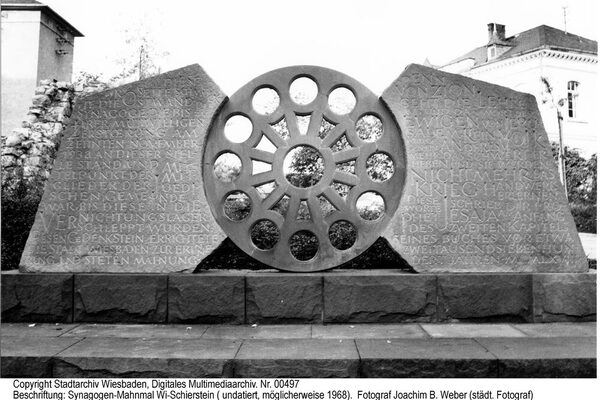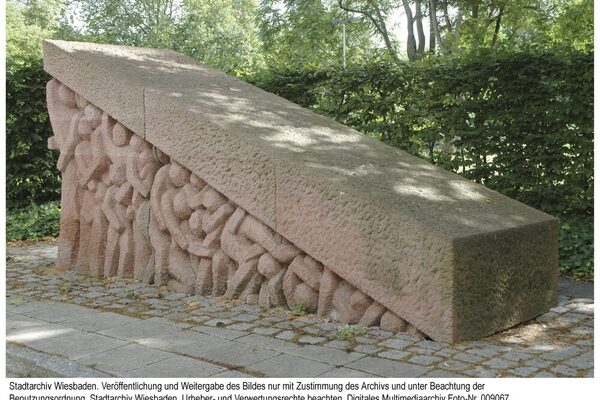Memorials to the victims of the Nazi regime
In 1953, a small memorial with a stele by Wiesbaden artist Egon Altdorf was erected on the site of the former synagogue on Michelsberg. It bears the inscription "Love is the conscience of the world". The area, which was later supplemented by several memorial plaques and renamed Heinrich-Heine-Anlage, was partially built over in the course of the creation of today's memorial to the murdered Jews of Wiesbaden. This structure, which was opened to the public on January 27, 2011, marks the entire area of the former synagogue grounds. The street layout divides it into two corresponding areas. The most important dates of the more than 1,500 people of Jewish origin who lived in the city and fell victim to Nazi racial mania are presented on a band of names that runs around the building at eye level and is illuminated after dark.
Since 1968, a memorial by Wiesbaden artist and art educator Prof. Dr. Wolf Spemann at Bernhard-Schwarz-Straße 17 in Schierstein has commemorated the synagogue there, which was attacked, desecrated and set on fire by Nazi racists in 1938. A stone rosette and the remains of the former surrounding wall were integrated into the memorial. A pillar from the entrance hall of the Michelsberg synagogue was placed as its only relic in the courtyard of the new synagogue built in 1966 at Friedrichstraße 33, where a bronze relief by Wolf Spemann with the prophet Jeremiah's dictum "Day and night I mourn the slain of my people" has also been on display since 1970. At the site of the former synagogue in Biebrich, a memorial plaque and a multilingual "Stele for Tolerance" created by Wiesbaden artist Karl-Martin Hartmann recall the fate of Jewish persecution. Since 1980, a memorial plaque at Poststrasse 7 in Bierstadt has also commemorated the synagogue that once stood there.
In 2002, a room was opened in the foyer of the town hall, where a wide range of information on the fate of Jewish persecution is available. In 1992, a memorial plaque with the names of the 16 residents of the former "Jews' house" who were deported and killed or driven to suicide was placed in front of the house at Alexandrastraße 8. In 1994, the artist Marc van den Broek designed a memorial in Nordenstadt with 14 rectangular steel steles bearing small brass plaques with the names of the Jews who were deported to the genocide camps on June 10 and August 28, 1942. Memorial plaques commemorate the lawyer and writer Dr. Sally Großhut, eight Jewish citizens murdered by the Nazi regime in Dotzheim, the expulsion of Jewish members of the Turn- und Sportgemeinde 1861 Sonnenberg, and three Soviet forced laborers murdered in Kloppenheim shortly before the end of the war. In the southern cemetery, there is a memorial stone of the Wiesbaden butchers' guild for its members who died during the First World War or for their sons, which was probably moved there from the abattoir grounds in the 1960s and on which an additional plaque commemorates seven colleagues listed by name who fell victim to Nazi racists in the concentration camp (section C 1, western edge). At the Bierstadt Jewish cemetery, a truncated pyramid with twelve engraved victims' names commemorates the members of the community who were deported there as well as those from Igstadt.
Since 2006, information steles have been successively erected at several authentic sites of persecution, such as in front of the outer wall of the former court prison at Albrechtstraße 29, then opposite Paulinenstraße 9, where a field office of the Frankfurt Gestapo was located at the time, as well as at Geschwister-Stock-Platz in memory of the Jewish children persecuted and murdered during the "Third Reich". Since 2010, the deportation memorial Schlachthoframpe, created by Frankfurt multimedia artist Vollrad Kutscher and Wiesbaden spray artist York Hauff, has provided information about the terrible events that once took place at the site to the east of the main railway station tracks. At the end of 1997, a plaque designed by the then Darmstadt sculptor Anne Haring was unveiled on the building at Luisenplatz 5, the former Old Mint, to commemorate the SA detention and torture center that was located there from spring to summer 1933.
The memory of numerous Wiesbaden opponents of National Socialism is preserved by memorial plaques in public spaces or similar forms of remembrance. The fate of foreign resisters is explained by plaques in the area of some schools named after them, such as the Wilhelm Leuschner and Carlo Mierendorff Schools, both in Mainz-Kostheim, and the Alfred Delp School in Wiesbaden-Frauenstein. A plaque commemorating Pastor D. Martin Niemöller was placed on the outside wall of his long-time residence at Brentanostrasse 3. In the Hessian State Parliament, a bust commemorates Wilhelm Leuschner, the namesake of the highest award of merit in this federal state. His portrait, like that of retired Colonel General Ludwig Beck, is also one of the 50 Hessian personalities featured in the installation "Himmel über Hessen. Licht-gestalten", which Vollrad Kutscher created for the new plenary building inaugurated in 2008. The "Unter den Eichen" concentration camp memorial in Carl-von-Ibell-Weg was opened in 1991. A permanent exhibition focuses on the city as an important location in the Nazi system of rule, the anti-Nazi resistance and the prison conditions of the mostly Luxembourgish Nazi opponents imprisoned there. Opposite Bahnhofstrasse 63, a large memorial initiated by Adam Strauß of the Association of German Sinti and Roma - Regional Association of Hesse and created by the artists Eugen Reinhardt and Josef Rainhar of the Sinti Workshop in Albersweiler in the Palatinate was handed over to the public in 1992.
In the southern cemetery, there is a field of honor for forced laborers and political victims of Nazi tyranny (section C 1) and a similar field with a memorial ensemble for 171 named victims from "euthanasia" institutions and concentration camps (section U 11). A memorial stone for the victims of this inhuman ideology was also erected in front of the steps to the main entrance of the former state house. In addition, around 40 streets and squares and not quite half as many schools and other buildings and institutions are named after victims of the Nazi regime or activists of the anti-Nazi resistance. In many cases, commemorative plaques have also been placed there. From 2005 to the summer of 2016, over 650 "Stolpersteine" were laid in the city center and in the suburbs with the names and dates of life, deportation and murder of mostly Jewish victims of the Nazi regime.
Literature
Gerber, Manfred (ed.): Memorial to the murdered Jews of Wiesbaden. SEG Stadtentwicklungsgesellschaft Wiesbaden (ed.), Wiesbaden 2011.
Maul, Bärbel/Ulrich, Axel: The Wiesbaden satellite camp "Unter den Eichen" of the SS special camp / Hinzert concentration camp. Edited by: City of Wiesbaden - Cultural Office/City Archive, Wiesbaden 2014.
"Here lived ...". An art project by Gunter Demnig. Stumbling Stones in Wiesbaden, 3 volumes: 2005-2008, 2009-2010, 2011-2013. ed.: Aktives Museum Spiegelgasse für deutsch-jüdische Geschichte in Wiesbaden; BÜNDNIS 90/DIE GRÜNEN, Rathausfraktion Wiesbaden, Wiesbaden 2009-2013.
Ulrich, Axel/Streich, Brigitte (ed.): Memorial site Schlachthoframpe. Ed.: City of Wiesbaden - Cultural Office/City Archive, Wiesbaden 2009.

